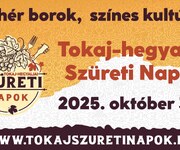In the smaller vineyards the familys even today harvesting with invited helpers. The host offers food and beverages for the harvesters, and they can bring back home samples from the grape and must. Major events and harvest marches were traditionally organized in the wine producing regions, similar to the crop harvesting traditions.

photo: Sikolya Tibor
The eating, drinking, singing, dancing, harvest march, and parades are the essential part of the harvest habits. The manner and form of these throughout the centuries are showing the image of a multicolored event.
The harvest marches that are organized in Tokaj-Hegyalja are still a living tradition today, they have a touristic allure. In the head of the march two maiden are proceeding, with a lad between them, who carries the so called “Coat of Arms with a Hoe”. Behind them two steward walking, behind the stewards another two lads are walking and carrying the figure of “baksus”. The baksus is a character, who sitting on a barrel with his legs crossed, with calabash and glass in his hands. The next are the girls, who sitting in a wagon carrying grapevine-wreath. The maidens, lads and children are creating uproar with watchman’s rattles. There are masked characters amongst the participants of the parade as well. For instance a man who dressed as woman, and ties a raffia to the arms of the viewers, and one must have to pay for exchange. The copper-dance was also the part of the parade. There were a puppet, that spinning on a wheel, and a dancing wheel on the march.
/In: Magyar Néprajz VII. Folklór 3., Budapest, 1990/








